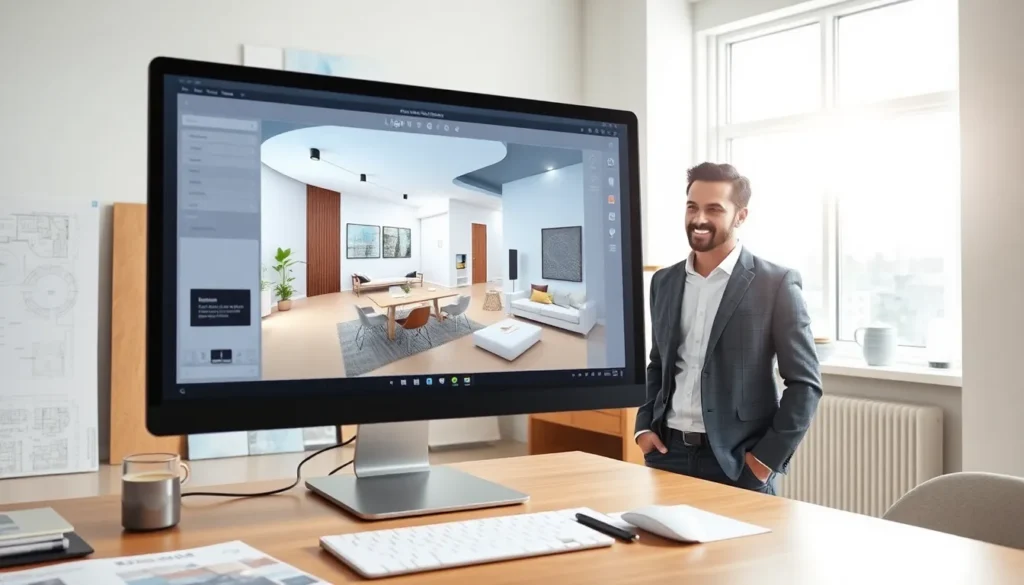Ever found yourself in a room feeling like the lighting was designed by an artist with a preference for shadows? Fear not. A lighting layout tool is here to save the day. This innovative resource helps you design the perfect illumination for any space, ensuring that ambience and functionality go hand in hand. Whether you’re a seasoned interior designer or a homeowner looking to enhance your living area, mastering the use of a lighting layout tool can elevate your project from dim to dazzling in no time. Let’s shed some light on this essential tool, shall we?
Table of Contents
ToggleWhat Is a Lighting Layout Tool?

A lighting layout tool is a software application or design tool that assists users in planning the placement of lights throughout a space. It provides visual representations and helps calculate optimal light levels, ensuring that every nook and cranny gets just the right amount of brightness. This innovative tool can come in various forms, from simple mobile apps to sophisticated software used by professional designers, helping visualize how lighting will interact with all the elements of a room. With the right lighting layout tool, users can experiment with different configurations easily, making decisions that could enhance not only the aesthetics of a room but also its functionality.
Benefits of Using a Lighting Layout Tool
Using a lighting layout tool comes with a plethora of benefits. For starters, it allows for precise planning. Users can visualize how light will affect colors and textures, resulting in more informed decisions. Not only does this save time during the installation phase, but it can also prevent costly mistakes down the line. Besides, lighting layout tools foster creativity. They enable individuals to experiment with different lighting styles, types, and intensities, eventually leading to unique and personalized designs. Another significant advantage is energy efficiency: many tools help users analyze the energy consumption of various lighting options, promoting sustainable choices.
Key Features to Look For
When selecting a lighting layout tool, certain key features should be prioritized. First, an intuitive user interface is crucial: the easier the tool is to navigate, the more time users can spend on creativity rather than struggling with functionality. Another important feature is customizable templates. These allow users to start with a framework and modify it to suit their needs, saving time and frustration. Also, look for tools that provide realistic 3D visualizations: this capability helps users understand how light will interact with the spaces to be designed. Finally, ensure the tool includes light level calculations to guarantee each area achieves desired brightness.
Types of Lighting Layout Tools
There are primarily four types of lighting layout tools to consider: software applications, online tools, mobile apps, and professional design software. Software applications often provide extensive capabilities, including 3D modeling and advanced calculation options. Online tools are typically user-friendly and accessible from any device, making them convenient for quick, at-home projects. Mobile apps cater to those who prefer designing on-the-go, while professional design software tends to feature robust capabilities suited for experienced designers handling complex projects. Each type serves different needs: so, understanding the various options will help select the best suited to your specific requirements.
How to Create an Effective Lighting Plan
Creating an effective lighting plan starts with a thorough understanding of the space. Identify the purpose of each area, are you aiming for a cozy atmosphere in the living room or heightened focus in an office? Once the objectives are established, use the selected lighting layout tool to experiment with various fixtures and placements. Ensure to visualize how light reflects and diffuses within the space, employing your tool’s 3D capabilities whenever possible. Factor in elements such as natural light availability and room colors, which can significantly influence lighting effectiveness. Once satisfied with a configuration, get feedback from others to refine the design further. Pushing through iterations will yield a well-thought-out, effective lighting plan that meets your needs and enhances the space.
Common Mistakes to Avoid
When utilizing a lighting layout tool, several common pitfalls can elevate costs and detract from the intended effects. First, avoid overcrowding a space with too many fixtures. While it may seem tempting to flood an area with light, too many sources can create harsh shadows and unflattering profiles. Secondly, neglecting to account for the room’s purpose can lead to mismatched lighting. Ensure the choices amplify the intended atmosphere rather than deterring from it. Also, don’t ignore the importance of layering: a successful lighting design typically incorporates ambient, task, and accent lighting. Finally, failing to visualize the end result can lead to disastrous surprises upon implementation. Always leverage the tools available, such as 3D rendering, to preemptively spot issues.

